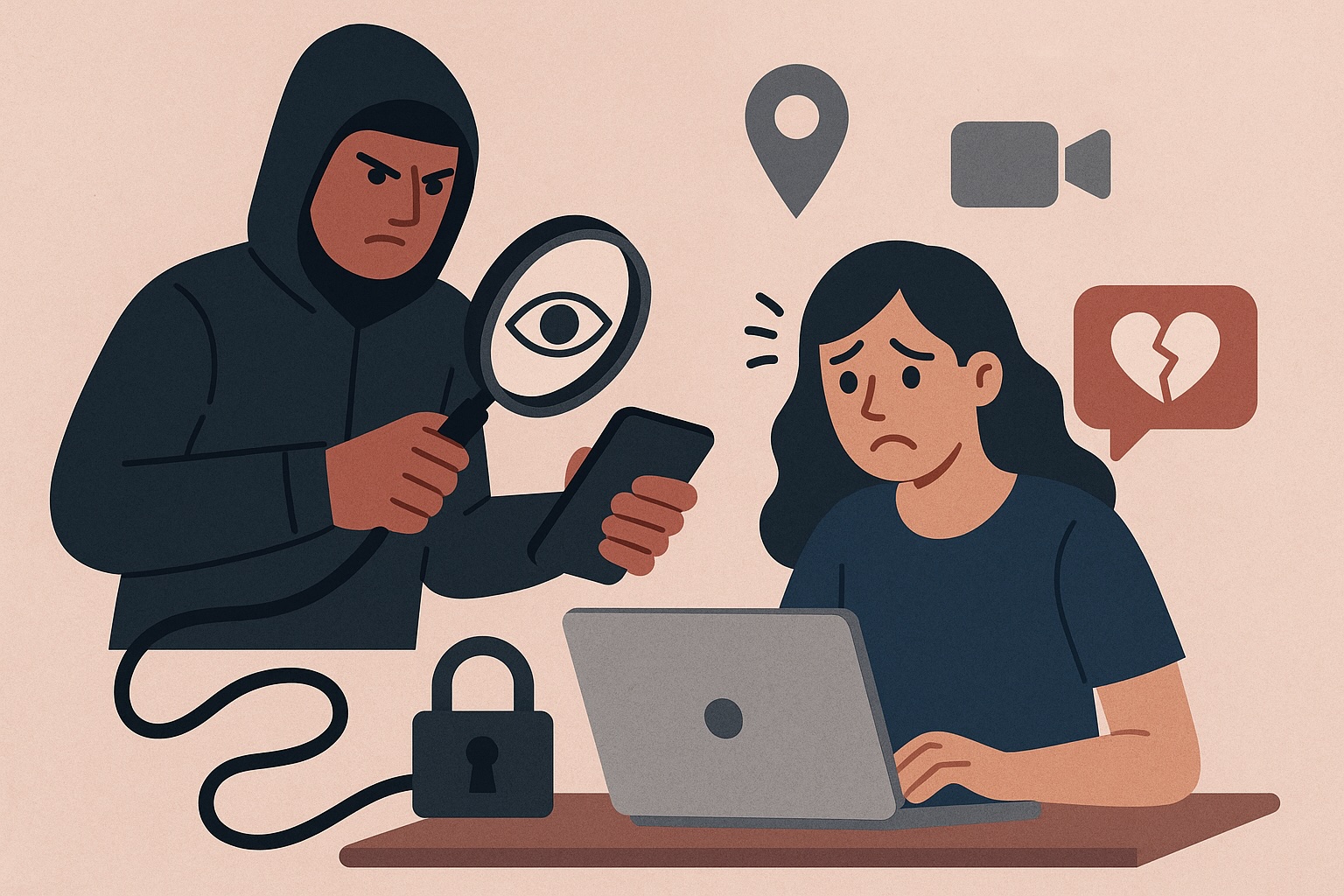Tech-Facilitated Abuse: How Abusers Use Technology and How to Protect Yourself Online
Abusers are using phones, apps, and smart devices to stalk, control, and harass their partners. Learn how tech-facilitated abuse works—and what you can do to stay safe online.

In today’s connected world, abusers are finding new ways to stalk, control, and intimidate their partners—using the very devices we rely on every day. This is called **tech-facilitated abuse**, and it's becoming more common in domestic violence cases across Ontario.
Here’s how it works—and how you can protect yourself.
***
### 🚨 How Abusers Use Technology to Control or Harm
* **Phone tracking apps or shared location services** (e.g., “Find My iPhone,” Google Maps)
* **Hidden surveillance software** installed on your phone, tablet, or laptop
* **Smart home devices** (cameras, doorbells, thermostats) used to monitor or harass
* **Social media stalking**—monitoring your likes, tags, or followers
* **Threatening or impersonating you online** (catfishing, fake profiles)
* **Harassing texts, emails, or DMs**
* **Recording or sharing intimate images without consent** (a criminal offense in Ontario)
* **Controlling access to your own devices** (changing passwords or disabling accounts)
> Many survivors don’t even realize they’re being tracked or watched digitally.
***
### 🧠 The Emotional Toll of Tech Abuse
* Constant fear that “they’re watching me”
* Feeling isolated because your abuser controls who you talk to
* Anxiety from receiving dozens—or hundreds—of messages
* Loss of privacy or control over your own digital life
* Depression or hypervigilance about being followed or exposed
***
### 🛡️ How to Protect Yourself Digitally
#### ✅ Phone and Device Safety
* Check for **unknown apps or settings** (especially ones with admin access)
* Use a **new password-protected device** if possible
* Avoid syncing your accounts with devices your abuser had access to
* Turn off **Bluetooth, GPS, and shared location services**
* Log out of all accounts and **enable two-factor authentication (2FA)**
#### ✅ Online and Social Media Safety
* Adjust privacy settings on Facebook, Instagram, LinkedIn, etc.
* Avoid posting real-time location updates or tagging friends
* Block the abuser and anyone trying to get information from you
* Consider **creating a new, clean email and social media account** for safety
* Screenshot abusive messages in case you need them for evidence
#### ✅ Smart Home and Shared Accounts
* Change Wi-Fi passwords and remove your abuser’s access
* Reset all smart home devices to factory settings
* Remove their accounts from shared Google, iCloud, or streaming services
* Avoid using shared calendars, contacts, or shared notes
***
### 📞 Legal Protections in Ontario
* **Non-consensual sharing of intimate images** is illegal under the Criminal Code
* You can request a **restraining order** that includes no electronic contact
* Harassment, threats, or digital stalking may lead to **criminal charges**
* You can speak to police, legal clinics, or a family lawyer about tech abuse
***
### 📌 Summary: Stay Safe Online from Tech-Facilitated Abuse
* ✅ Abusers can use phones, apps, and smart devices to stalk or control
* ✅ Survivors often don’t realize they’re being watched
* ✅ Steps like changing passwords and checking devices can help
* ✅ Legal remedies exist—don’t wait to ask for help
* ✅ You're not overreacting—your safety and peace of mind matter
***
### 💬 Where to Get Help in Ontario
* **Assaulted Women’s Helpline (24/7):** 1-866-863-0511
* **Ontario Network of Victim Service Providers:** Offers support with tech and safety planning
* **Barbra Schlifer Clinic:** Legal support for digital abuse cases
* **Legal Aid Ontario:** 1-800-668-8258
* **YWCA Tech Safety Toolkit:** [ywcacanada.ca](https://www.ywcacanada.ca/) – Free digital security tips for survivors
***
### Frequently Asked Questions (FAQs)
#### 1. Is it illegal for my partner to share my private photos in Ontario?
Yes. In Canada, it is a criminal offence to distribute an intimate image of a person without their consent. If this is happening to you, you can report it to the police.
#### 2. How can I tell if my ex is tracking my phone?
Signs that your phone may be monitored include the battery draining much faster than usual, your device being unexpectedly hot, or seeing unfamiliar apps you don't remember installing. If you suspect you're being tracked, it's safest to stop using that phone for sensitive communications.
#### 3. What is the single most important step for online safety after leaving an abuser?
The most important first step is to change the password on your primary email account and turn on two-factor authentication (2FA). Your email is often the key to resetting the passwords on all your other accounts, so securing it first is critical.
#### 4. My ex keeps making new fake profiles to harass me online. What can I do?
This is a form of criminal harassment (stalking). You should block each new profile without engaging, take screenshots of the profile and any messages, and report the pattern of behaviour to the police. This evidence can also be used to get a restraining order.
#### 5. Can a restraining order include conditions about digital abuse?
Yes. When you apply for a restraining order, you can specifically ask the judge to include conditions that prohibit the abuser from contacting you through any electronic means, including social media, and from posting about you online.
#### 6. Where can I get help creating a technology safety plan?
Organizations like Tech Safety Canada (run by Women's Shelters Canada) have excellent online resources. You can also get direct, confidential help with creating a safety plan that includes digital security from your local women's shelter or by calling a 24/7 crisis line like the Assaulted Women's Helpline (1-866-863-0511).
